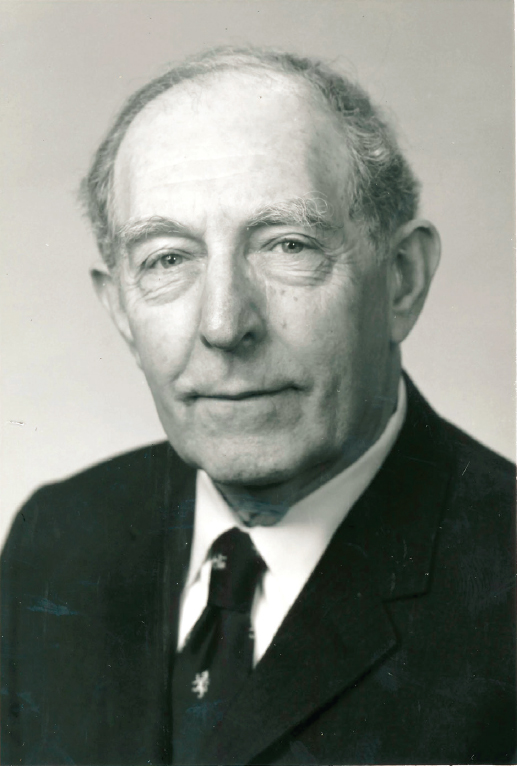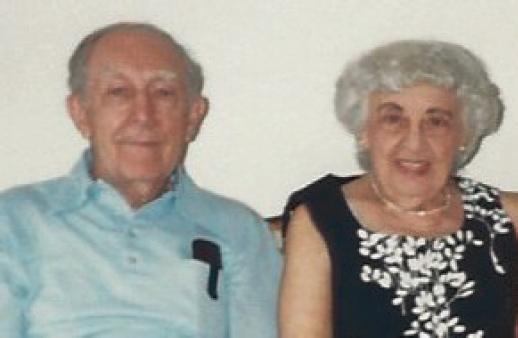LOUIS LANDWEBER
1912–1998
Elected in 1980
“Research, design, and educational contributions to modern naval architecture and marine engineering.”
BY S.K. CHOW, ROBERT ETTEMA, YU-TAI LEE, AND FREDERICK STERN
SUBMITTED BY THE NAE HOME SECRETARY
LOUIS LANDWEBER, professor emeritus of mechanics and hydraulics, Iowa Institute of Hydraulic Research (IIHR)–Hydroscience and Engineering, passed away January 20, 1998, at the age of 86. A distinguished and widely recognized leader and a theoretician whose insights extended well beyond the ordinary, he was the “Father of Ship Hydrodynamics” at IIHR, with a career that spanned decades of the 20th century critical to the development of naval ship hydrodynamics.
His contributions to the theory and practice of naval architecture and marine engineering were groundbreaking. Building on his formal education as a physicist and mathematician, his work bridged to engineering applications. Few engineers could match his understanding and elegant formulation of fluid mechanics as applied to water movement around bodies in water, from ships and submarines to drifting objects such as icebergs.
“Lou Landweber had a thirst for knowledge that never ran dry,” noted the University of Iowa’s Engineering Dean Alec Scranton during Landweber’s induction to the Legacy of Iowa Engineering on April 25, 2017. He added, “Soft-spoken, Landweber was renowned for his problem-solving ability. He always offered any visitor a chair alongside his own, pulled out a writing shelf, positioned his pencil and
writing pad, and gently talked his visitor through the problem, step by step.”
Lou was born to Joseph and Lena Landweber in New York City on January 8, 1912. His father worked as a tailor, and his mother focused her energies on raising their four sons and managing the family. He attended the city’s public schools and then enrolled at the City College of New York, where at age 20 he received his bachelor’s degree in mathematics as well as the Ward Medal for Physics and the Belden Prize for Mathematics.
Upon graduation he went to work as a junior physicist at the US Experimental Model Basin at the Washington Navy Yard. He found his work fascinating, but recognized the need to deepen his knowledge of mathematics and fluid mechanics. Accordingly, he began graduate studies at George Washington University and in 1935 attained his master’s degree in physics. Also that year, he married Matilda (Mae) Herschfeld, sister of one of his classmates.
Beginning in 1940 he led a group that distinguished itself in war-related research, primarily in resolving key hydrodynamic aspects associated with the way minesweeper ships handled mines. For this work he received the Navy’s Meritorious Civilian Service Award in 1947.
Soon after the war the Navy expanded Landweber’s research group to become the Model Basin’s Hydrodynamics Division. While continuing to lead the group, his research led to his PhD in physics (1951) from the University of Maryland (where he also taught concurrent with his work and studies). His thesis, “An Iteration Formula for Fredholm Integral Equations of the First Kind with Application to the Axially Symmetric Potential Flow about Elongated Bodies of Revolution,” initiated the so-called Landweber iteration, an algorithm to solve ill-posed linear inverse problems, which are ubiquitous in ship hydrodynamics (e.g., when formulating ship motions and ship waves). It has been extended to solve nonlinear problems with constraints.
While pursuing his PhD degree Landweber was promoted to head of the Hydrodynamics Division of the David Taylor
Model Basin in Carderock, Maryland (now called the Naval Surface Warfare Center, Carderock Division). This Navy lab has world-renowned naval ship technology testing facilities and research staff who study ship-related problems and design future naval ships—a line of work that fascinated Landweber for the rest of his life.
In 1954 he accepted an offer to work at the University of Iowa. Hunter Rouse (NAE 1966), IIHR director (1944–66), invited him as both researcher and full professor of mechanics and hydraulics. To sweeten the deal, the Office of Naval Research (ONR) funded the conversion of one of IIHR’s basement river channels, built in 1919 as the original Hydraulics Laboratory, into a large ship towing tank—a narrow channel through which small-scale ship models would be pulled and assessed under various circumstances. This tank, at the time one of the few such facilities in the nation, solidified IIHR’s capabilities to experimentally examine the motion of a ship.
Landweber immediately took over theoretical and experimental studies connected to naval architecture, ship hydrodynamics, and the fluid mechanics of body motion in water. Within a year, Rouse was very pleased that his new hire had quickly assumed most of the administrative responsibility for naval projects.
Landweber felt that academics suited him much better than civil service work, and he happily set to work at IIHR as a researcher, educator, and innovator. His impact was transformative and he developed a strong theoretical and experimental research program in ship hydrodynamics that continues. Under his guidance, IIHR became an international leader in research related to naval architecture and ship hydrodynamics, with ongoing financial support from ONR.
Landweber and his colleagues conducted research projects on analysis of wakes, drag of truncated bodies, ship vibration, ship rolling, added-mass considerations, resistance from waves, turbulence, and cavitation. He made major theoretical contributions to the prediction of waves around ship hulls, of resistance due to waves (using ideal-fluid theory), and of friction (using boundary-layer theory).
He was among the first to explore the potential of computational fluid dynamics (CFD), which is now the main thrust for solving complex flow problems, including ship hydrodynamics. These early efforts in the 1960s provided a foundation for later work at IIHR. Landweber laid out the problem—usually a classical equation-solving problem—and his associate or students would program it using their computer expertise. Together, they would solve the problems with Landweber’s insightful understanding, keen mathematical sense, and trusty slide rule.
Throughout his career he addressed many mathematical aspects of ship hydrodynamics and fluid mechanics. For example, he focused considerable effort on the application of the Lagally theorem for estimating the forces and moments acting on a rigid body (e.g., a ship hull or an iceberg) moving through water treated as an inviscid and incompressible fluid. In addition, he helped enhance knowledge in the field by editing English translations of Russian texts on ship hydrodynamics.
Landweber not only was a first-class researcher but also possessed an ability to spot talent. In 1970 V.C. Patel was looking for a job; his position at Lockheed Martin in Georgia had ended. He and his wife liked life in the United States, but where to go next? He wrote three letters seeking a position—one of them to Lou Landweber. Landweber responded almost immediately with a handwritten note inviting him to come to IIHR to present a seminar. “Lou and his wife Mae picked me up at the airport,” Patel remembered. “They took me to a Chinese restaurant—they made me feel so welcome.” He gave a seminar about CFD with relation to aerospace. “Nothing to do with hydraulics or ships!” Patel laughed. But Landweber immediately saw how Patel’s work on the boundary layers of airplanes could be applied to ships. He wrote a note to Patel promising to speak to then-IIHR director Jack Kennedy (NAE 1973) as soon as he returned from vacation. “Within a couple of weeks, I got a telegram offering me a job—from Jack Kennedy!” Patel says. He went on to serve IIHR for decades, culminating as director (1994–2004).
Landweber’s career at IIHR was among the longest and most productive in the institute’s history. Even after his retirement in 1982 at age 70 and well into his 80s, he continued to secure grant funding, conduct research, publish papers, and mentor graduate students, until 1995, when health problems restricted him to his home. He was the author, coauthor, or editor of some 150 technical papers, reports, monographs, and books in the fields of hydrodynamics and naval architecture. He ushered more than 50 MS and PhD students through their studies. They remember his integrity, warmth, support, and humor—characteristics that rival even his vast technical achievements in their recollection.
Through interactions with former students working in various industries, he expanded applications of his well-developed knowledge base beyond ship-related applications. A good example was his assistance to one of the authors (SKC; 1967 PhD) working on flow predictions for pumps at the Westinghouse Research & Development Center in Churchill, Pennsylvania. Landweber’s potential theory was applied to a centrifugal pump and in 1978 their joint paper, “Calculation of Flow through Two-Dimensional Centrifugal Impeller by Method of Hydrodynamic Singularities,” won the first Henry R. Worthington North American Technical Awards Competition, sponsored by the Polytechnic Institute of New York and Worthington Pump Inc. During the same time, another of the authors (Y-TL; 1978 PhD) started working in Chow’s group, using the similar potential theory to predict both flows in three-dimensional centrifugal pumps and electromagnetic fields at end-regions of turbogenerators.
In addition to his NAE membership, Landweber was a fellow of the Society of Naval Architects and Marine Engineers (SNAME) and American Academy of Mechanics. Among his many honors, he was selected as the Fifth David W. Taylor Lecturer 1 and received SNAME’s Kenneth S.M. Davidson
___________________
1 His presentation, “On Irrotational Flows Equivalent to the Boundary Layer and Wake,” is available at the online Defense Technical Information Center, https://apps.dtic.mil/sti/pdfs/ADA062002.pdf.
Medal for outstanding accomplishment in ship research, both in 1978; honored by a special session at the Third Engineering Mechanics Division Specialty Conference of the American Society of Civil Engineers in 1979; named Georg Weinblum Memorial Lecturer for 1981 (“Interactions between Viscosity and Ship Waves”); and honored at the Sixth International Conference on Numerical Ship Hydrodynamics, Iowa City, in 1993.
Although Landweber died more than two decades ago, he is remembered fondly by his many friends and colleagues at IIHR. Kind, calm, friendly, and unassuming, he had the ability to get along with everyone and always made time to meet and talk with visitors to IIHR. He was a generous mentor, freely offering his time and support to both colleagues and students. “He was a very dear man,” Patel remembered with a smile. Landweber’s successor in ship hydrodynamics at IIHR, Fred Stern, agreed. “He was a real sweetheart…. always a very helpful and kind fellow.” Landweber’s death was a loss that profoundly shook the entire IIHR family. Yet, as Stern said at the funeral, the pain was “somehow accompanied by simultaneous feelings of happiness, joy, and pride for having known—as a close friend, surrogate father, and mentor—such a man as Lou Landweber.”
Mae passed away March 28, 2001. They are survived by sons Peter (born 1940), a mathematician, and Victor (born 1943), a photographic artist inspired in part by his father’s lifelong hobby of photography, and four grandchildren.










